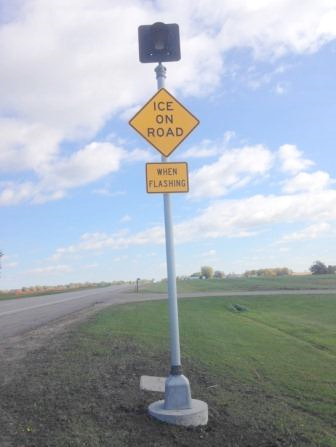The longest winter in recent memory might have ended, but MnDOT’s traffic and maintenance staff are already planning how to make future winters easier on Minnesota drivers.
Recently, the Regional Transportation Management Center was awarded funding to deliver real-time winter weather warnings via its roadside and overhead highway message signs. The RTMC displayed blizzard warnings for the first time during six storms last winter, but the alerts had to be manually entered.
“This is similar information that you receive on your cell phone or the evening news,” said Brian Kary, RTMC Traffic Operations director. “But for somebody who’s traveling down I-90 and just passing through, they might not realize that they’re entering an area with a blizzard.”
Another initiative aims to expand the road condition data that’s available during winter storms by piloting the use of mobile sensors on maintenance supervisor trucks and above-ground sensors at select Road and Weather Information System sites.
Both projects are among eight research implementation projects recently selected for funding by the governing board for MnDOT’s transportation research program.

Weather Alerts
Minnesota has nearly 300 Dynamic Message Signs, which currently issue real-time warnings about traffic incidents, road work and congestion. Around 200 are in the Twin Cities metro; the rest are in Greater Minnesota.
Kary’s two-year project will develop a system that can automatically relay critical weather alerts, which change frequently, are labor-intensive and error-prone when physically entered. Only blizzard warnings from the National Weather Service are initially planned, but the system will be capable of broadcasting all types of weather alerts.
A number of other states already issue weather alerts via their Dynamic Message Signs, so MnDOT has case studies to look at.
It’s possible that the signs could also someday relay information from MnDOT’s Maintenance Decision Support System and roadside weather sensors. A current pilot project uses weather sensors and flashings on a rural stretch of highway near Dassel Cokato High School to warn motorists and notify maintenance staff of unexpected blow ice.

Improving Road Condition Information
Over the next two years, the Maintenance Office will test the use of mobile and above-ground sensors to expand the geographic coverage of RWIS sites, which feed valuable weather and road surface information to highway operations managers and advanced traveler information systems. This might lead to the elimination of in-road sensors, which require lane closures to maintain and must be replaced during road construction projects.
The mobile sensors will collect road condition information, such as temperature, humidity, due point, and friction, from five maintenance supervisor trucks. The other non-invasive sensors will be attached to an RWIS tower or a pole near the roadway and use laser technology to read road surface temperature and condition (water ice, slush and snow).
See this related news story from KSTP-TV.

